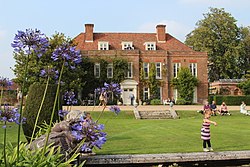Phillips Gybbon
Phillips Gybbon (11 October 1678 – 12 March 1762), of Hole Park, Rolvenden, in Kent, was an English Whig politician who sat in the House of Commons between 1707 and 1762.

Gybbon was the son of Robert Gybbon of Hole Park, and his wife Elizabeth Phillips, daughter of John Phillips of St. Clement Danes. He travelled abroad in Holland and Germany and entered Middle Temple in 1694. He succeeded his father in 1719.[1]
Gybbon entered Parliament in 1707 as Whig Member of Parliament for Rye, and represented the constituency until his death 55 years later, eventually becoming Father of the House of Commons from 1749. Early in his career he was appointed a Commissioner of Revenue in Ireland, and in the 1720s was Chairman of the Committee of Privileges and Elections. From 1726 to 1730, he was Surveyor-General of Land Revenues. For the next few years he was in opposition, supporting Pulteney against Robert Walpole's administration. On Walpole's fall in 1742, Gybbon was appointed a Lord of the Treasury in Wilmington's government, retaining the post after Henry Pelham replaced Wilmington in 1743 but losing office in the reshuffle after Carteret was sacked at the end of 1744.[2]
He died in 1762, having married Catherine, the daughter of Honor Bier, with whom he had an only daughter. She left Hole Park to a Mrs Jefferson who was married to a John Beardsworth.[2]
References
[edit]- ^ "GYBBON, Phillips (1678-1762), of Hole Park, Rolvenden, Kent". History of Parliament Online (1690-1715). Retrieved 25 August 2018.
- ^ a b "GYBBON, Phillips (1678-1762), of Hole Park, Rolvenden, Kent". History of Parliament Online (1715-1754). Retrieved 25 August 2018.
- Robert Beatson (1807). A chronological register of both houses of the British Parliament, from the union in 1708, to the third Parliament of the United Kingdom of Great Britain and Ireland, in 1807. printed for Longman, Hurst, Rees, and Orme [by J. Chalmers & Co.]
- Lewis Namier & John Brooke, The History of Parliament: The House of Commons 1754-1790, London: HMSO, 1964)


 French
French Deutsch
Deutsch